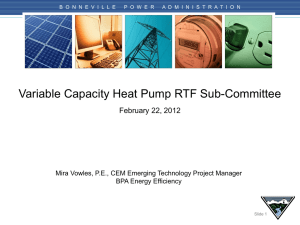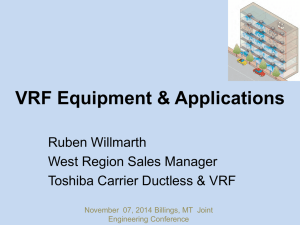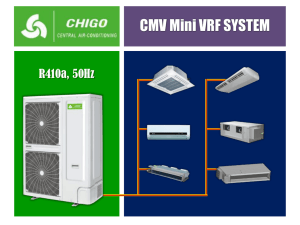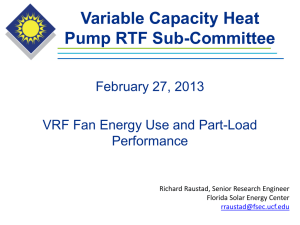VCHP Energy Efficiency Measure Development Roadmap
advertisement
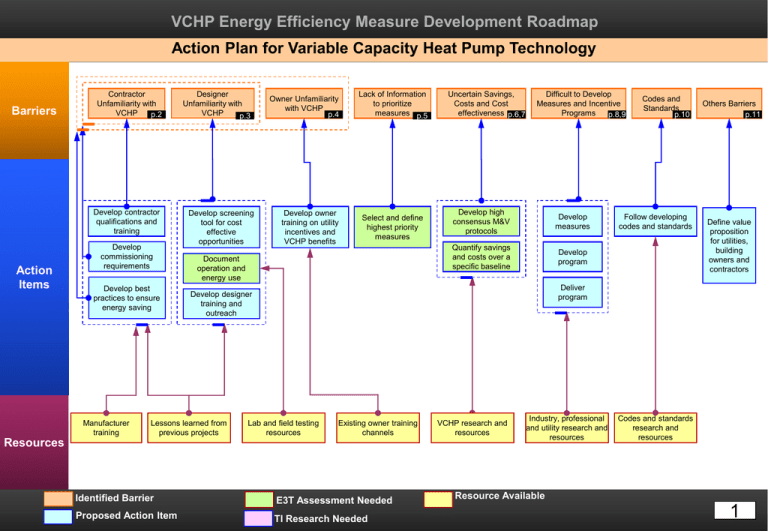
VCHP Energy Efficiency Measure Development Roadmap Action Plan for Variable Capacity Heat Pump Technology Barriers Contractor Unfamiliarity with VCHP p.2 Develop contractor qualifications and training Action Items Develop commissioning requirements Develop best practices to ensure energy saving Manufacturer training Designer Unfamiliarity with VCHP p.3 Develop screening tool for cost effective opportunities Owner Unfamiliarity with VCHP p.4 Develop owner training on utility incentives and VCHP benefits Lack of Information to prioritize measures p.5 Select and define highest priority measures Document operation and energy use Uncertain Savings, Costs and Cost effectiveness p.6,7 Difficult to Develop Measures and Incentive Programs p.8,9 Develop high consensus M&V protocols Develop measures Quantify savings and costs over a specific baseline Develop program Follow developing codes and standards Others Barriers p.11 Define value proposition for utilities, building owners and contractors Deliver program Develop designer training and outreach Lessons learned from previous projects Codes and Standards p.10 Lab and field testing resources Existing owner training channels Resources Identified Barrier E3T Assessment Needed Proposed Action Item TI Research Needed VCHP research and resources Industry, professional and utility research and resources Codes and standards research and resources Resource Available 1 VCHP Energy Efficiency Measure Development Roadmap Contractor Unfamiliarity with VCHP Manufacturer training is difficult to access (nearest training center is in Southern California) Lack of contractor knowledge/experience Barriers Poor installation even by the trained contractors Technology misapplication can affect deployment Develop commissioning requirements Develop contractor qualifications and training Develop best practices to ensure energy savings Action Items Lessons learned from ASHRAE Headquarters VRF demonstration project Investigate lessons learned from Oakridge residential DHP field testing Get early copies of ASHRAE 90.1 2010 VRF mechanical tables Investigate lessons learned from Energy Trust New Buildings program has provided incentives for new community college buildings in Southern Oregon, installing Mitsubishi VRFs. M&V-completion date is Fall 2011 Erin Rowe Get early copies of ASHRAE VRF Handbook Chapter, which is scheduled to be available Spring of 2012 Investigate savings and lessons Investigate lessons learned from Ecotope learned from Corvallis Wild Life single-head DHP report (residential), Preserve VRF system with HRV including both field and lab testing. Contact and economizers Bob Davis or David Baylon at Ecotope Mark Jerome Resources Investigate new products and features, including US-centric controls, heat pump boilers, data center rack cooling, etc. Mike Cundiff Daikin provides online classes (http://www.daikinac.com/comm ercial/trainingOverview.asp?sec =training) VRF contractor training in Irvine, California Mark Jerome Investigate Cascade Energy Engineering VRF system; they have been monitoring system energy use for 5 years Mike Cundiff Collaborate with "Center for Built Environment" for post occupancy evaluation of comfort and behavior Paul Delaney Identified Barrier E3T Assessment Needed Proposed Action Item TI Research Needed Resource Available 2 VCHP Energy Efficiency Measure Development Roadmap Designer Unfamiliarity with VCHP Proprietary equipment makes it hard to understand or commission Technology misapplication Some applications are not appropriate for VRV e.g. large OSA with not many zones Barriers Codes and standards were not available until recently Questionable cost effectiveness of economizers and ground coupled applications Lack of robust Lack of performance design and data to validate modeling tools manufacturer claims Develop designer training and outreach Get early copies of ASHRAE VRF Handbook Chapter, which is scheduled to be available Spring of 2012 Document operation in lab tests Develop commissioning requirements Collaborate with "Center for Built Environment" for post occupancy evaluation of comfort and behavior Paul Delaney TI Project 216 EPRI Lab Testing Resources Unfamiliar with controls Engineers are designing systems around the technologies that they are more comfortable with VCHP does not fit into standard design process Not all applications of VCHP systems with simultaneous heating and cooling capability are cost effective Action Items Lack of education in design and construction fields on technology Technology misapplication can affect deployment AHRI 1230 Mike Cundiff NREL may be a resource for lab testing VRF systems Bruce Baccei Develop best practices to ensure energy savings Develop screening tool for cost effective opportunities Lessons learned from ASHRAE Headquarters VRF demonstration project Investigate lessons learned from Oakridge residential DHP field testing Get early copies of ASHRAE 90.1 2010 VRF mechanical tables Daikin provides online classes (http://www.daikinac.com/comme rcial/trainingOverview.asp?sec=tr aining) Investigate new products and features, including US-centric EWEB controls, heat pump boilers, commissioning data center rack cooling, etc. case study Mike Cundiff Investigate lessons learned from Energy Trust New Buildings program has provided incentives for new community college buildings in Southern Oregon, installing Mitsubishi VRFs. M&V-completion date is Fall 2011 Erin Rowe Get early copies of ASHRAE VRF Handbook Chapter, which is scheduled to be available Spring of 2012 Investigate savings and lessons Investigate lessons learned from Ecotope learned from Corvallis Wild Life single-head DHP report (residential), Preserve VRF system with HRV including both field and lab testing. Contact and economizers Bob Davis or David Baylon at Ecotope Mark Jerome Identified Barrier E3T Assessment Needed Proposed Action Item TI Research Needed Investigate Cascade Energy Engineering VRF system; they have been monitoring system energy use for 5 years Mike Cundiff Resource Available 3 VCHP Energy Efficiency Measure Development Roadmap Owner Unfamiliarity with VCHP Perception of risk, uncertain owner and user, occupant acceptance There are a lot of HVAC options in the market so this may not be perceived as the best option for a given application Unsure of system operation Owners are not familiar with the systems Barriers Lack of data and market knowledge to promote technology Uncertainty in the market about the benefits of the system over the other systems Develop owner training on utility incentives and VCHP benefits Develop best practices to ensure energy savings Action Items Lessons learned from ASHRAE Headquarters VRF demonstration project Investigate lessons learned from Oakridge residential DHP field testing Get early copies of ASHRAE 90.1 2010 VRF mechanical tables Investigate new products and features, including US-centric controls, heat pump boilers, data center rack cooling, etc. Mike Cundiff Investigate lessons learned from Energy Trust New Buildings program has provided incentives for new community college buildings in Southern Oregon, installing Mitsubishi VRFs. M&V-completion date is Fall 2011 Erin Rowe Resources Collaborate with "Center for Built Environment" for post occupancy evaluation of comfort and behavior Paul Delaney NEEA and BOMA owner training Get early copies of ASHRAE VRF Handbook Chapter, which is scheduled to be available Spring of 2012 Investigate savings and lessons Investigate lessons learned from Ecotope learned from Corvallis Wild Life single-head DHP report (residential), Preserve VRF system with HRV including both field and lab testing. Contact and economizers Bob Davis or David Baylon at Ecotope Mark Jerome Investigate Cascade Energy Engineering VRF system; they have been monitoring system energy use for 5 years Mike Cundiff Identified Barrier E3T Assessment Needed Proposed Action Item TI Research Needed Resource Available 4 VCHP Energy Efficiency Measure Development Roadmap Lack of Information to Prioritize Measures Uncertain cost effectiveness for some applications Hard to define baselines to make comparisons Barriers Select and define highest priority measures Identify when and where designers include electric resistance heat with VRF systems Understand engineering, Installation, ownership, utility barriers Evaluate whether the amount of VCHP refrigerant is an issue Action Items ASHRAE 90.1 2010 Appendix G Quantify savings for replacing electric heat Investigate savings for baselines that do not have cooling Develop cost database Distribute and post EPRI VRF market studies, commissioned by BPA, when they are available Mira Vowles Preliminary screening of cost effectiveness of measures Screen for where VRF HR systems are cost-effective Verify the significance of duct losses and feasibility of M&V Mitsubishi VRF analysis based on EnergyPro model Nick Fernandez Evaluate top identified applications Identify installations where savings can be verified VCHP measure potential research and studies (Power plan) Resources Identified Barrier E3T Assessment Needed Proposed Action Item TI Research Needed Resource Available 5 VCHP Energy Efficiency Measure Development Roadmap Uncertain Energy Savings, Costs and Cost Effectiveness Uncertain savings Barriers Uncertain cost Incremental costs of VRF systems could be higher or lower than baseline systems Unknown equipment life Condensate piping and pumps are a costly oversight Skepticism about savings and real cost/benefit ratio Utilities can not incent if incremental cost is negative Quantify savings and costs over a specific baseline Select baseline Establish measure life Quantify non-energy benefits (O&M, gas savings, productivity due to improved comfort, etc.) to fully account for additional cost effective measures Action Items Develop models to quantify savings for top priority measures Quantify energy savings for night setback Quantify annual energy savings, benefits, costs TI Project 216 EPRI VRF HR Lab Testing Use AHRI 1230 equipment performance ratings (EER, COP, IEER) to estimate savings, including water cooled VRF system savings over air cooled VRF systems Mike Cundiff Document savings Mitsubishi VRF trade-off for analysis based on VRF HR EnergyPro model without economizers, Nick Fernandez Paul Doppler Jim Benville Resources Investigate lessons learned from PNNL/NEEA work to disaggregate electrical loads, and use to determine actual VRF system energy use Nick Fernandez Investigate savings and lessons learned from Corvallis Wild Life Preserve VRF system with HRV and economizers Mark Jerome Identified Barrier E3T Assessment Needed Proposed Action Item TI Research Needed Distribute and post EPRI VRF market studies, commissioned by BPA, when they are available Mira Vowles Investigate lessons Investigate new learned from BC Hydro products and VRF office building retrofit features, including in Vancouver; combination US-centric Investigate life of modeled/measures controls, heat of Asian savings. Presented at pump boilers, systems Emerging Tech data center rack Conference in Sacramento cooling, etc. in Nov 2010 Mike Cundiff Ron Domitrovic Resource Available 6 VCHP Energy Efficiency Measure Development Roadmap M&V for Uncertain Energy Savings Existing M&V approaches like energy modeling and deemed savings are not proven for VRF systems Barriers Complex systems-hard to accurately measure and quantify savings Develop high consensus M&V protocols Action Items Challenges metering commercial VCHP systems Identify installations where savings can be verified Possible opportunity for field testing in a set of test bed commercial buildings that are being constructed in Richland, WA at PNNL's headquarters. Nick Fernandez Share results from EPRI VRF&DHP EE Demo's Mira Vowles RTF VCHP Sub committee IPMVP Resources Document M&V protocols from field tests Identified Barrier E3T Assessment Needed Proposed Action Item TI Research Needed Resource Available 7 VCHP Energy Efficiency Measure Development Roadmap Product/Service Area : Difficult to Develop Measures Uncertain cost Uncertain savings Unknown equipment life Complicated utility incentive process Higher first cost VRF may add cooling to uncooled baselines Barriers Develop equipment based measures Describe energy savings time-ofoccurrence and duration: Load Shape, Lifetime Action Items Document magnitude and longevity of the incremental electric energy savings. Define the value proposition for the utilities, building owners and contractors Quantify baseline EUIs for building types Develop simple savings calculators based on documented performance to be nimble, reduce reliance on energy models and lower program delivery cost Evaluate cost effectiveness of measures Resources Develop performance based measures Develop simple system start-up requirements for incentives Consider upstream program ($/ton), similar to SCE, based on energy models Develop measure specific M&V protocols Verify tenant billing system for M&V VRF Pilot to verify measure savings Develop whole building savings estimation and M&V using billing data Design program to minimize free ridership Determine sample size to quantify statistically significant savings Use AHRI 1230 equipment performance ratings (EER, COP, IEER) to estimate savings, including water cooled VRF system savings over air cooled VRF systems Mike Cundiff Possible opportunity for field testing in a set of test bed commercial buildings that are being constructed in Richland, WA at PNNL's headquarters. Nick Fernandez Field test M&V protocols Share results from EPRI VRF&DHP EE Demo's Mira Vowles RTF VCHP Sub committee Investigate incorporating VRF systems into office of the future pilot projects which have 30-50% savings goals. Contact Amy Cortese, with New Building Institute, amy@newbuildings.org Bruce Baccei Summarize lessons learned based on evaluation of SCE's upstream VRF incentive program Paul Delaney IPMVP ASHRAE 90.1 2010 VRF mechanical tables Identified Barrier E3T Assessment Needed Proposed Action Item TI Research Needed Resource Available 8 VCHP Energy Efficiency Measure Development Roadmap Difficult to Develop Incentive Programs Usually adds cooling to a space that did not have cooling before Higher initial cost Barriers Develop VCHP Incentives Develop equipment based measures Action Items Develop performance based measures Develop VRF measures, possibly whole building/pay for performance incentives Develop best practices and specifications for ERV design and operation Quantify baseline EUIs for building types Develop best practices to prevent electric resistance heat operation Consider upstream program ($/ton), similar to SCE, based on energy models Quantify savings for baselines that do not have cooling Evaluate unoccupied temperature set-back/set-up, DOAS control, electric resistance heat lock-out, low-ambient performance and optimal start capabilities -develop best practices and pay for performance Develop simple system startup requirements for incentives Determine free ridership. Design program to minimize free ridership Summarize lessons learned based on evaluation of SCE's upstream VRF incentive program Paul Delaney Resources Identified Barrier E3T Assessment Needed Proposed Action Item TI Research Needed Resource Available 9 VCHP Energy Efficiency Measure Development Roadmap Codes and Standards Costly to meet ventilation codes with VCHP systems Codes and standards are still being developed Safety concerns over refrigerant leaks Difficult to meet net zero Evaluate whether the amount of VCHP refrigerant is an issue Follow developing IECC net zero requirements Barriers Follow developing codes and standards Follow developing IECC and other economizer code exceptions Evaluate whether the amount of VCHP refrigerant is an issue Action Items Follow developing IECC and other economizer code exceptions Follow developing IECC net zero requirements Document savings trade-off for VRF HR without economizers, Paul Doppler Jim Benville IECC 2012 Get early copies of ASHRAE 90.1 2010 VRF mechanical tables IECC 2012 ASHRAE refrigerant standard Get early copies of ASHRAE VRF Handbook Chapter, which is scheduled to be available Spring of 2012 Resources Identified Barrier E3T Assessment Needed Proposed Action Item TI Research Needed Resource Available 10 VCHP Energy Efficiency Measure Development Roadmap Other Barriers Cheaper install equals less commission for sales man Barriers Inertia of traditional (US) HVAC manufacturing design and contracting system Negative experiences e.g. ASHRAE HQ Issues Define the value proposition for the utilities, building owners and contractors Action Items Lessons learned from ASHRAE Headquarters VRF demonstration project Investigate lessons learned from Oakridge residential DHP field testing Investigate lessons learned from Energy Trust New Buildings program has provided incentives for new community college buildings in Southern Oregon, installing Mitsubishi VRFs. M&V-completion date is Fall 2011 Erin Rowe Investigate lessons learned from BC Hydro VRF office building retrofit in Vancouver; combination of modeled/measures savings. Presented at Emerging Tech Conference in Sacramento in Nov 2010 Ron Domitrovic Resources Identified Barrier E3T Assessment Needed Proposed Action Item TI Research Needed Get early copies of ASHRAE VRF Handbook Chapter, which is scheduled to be available Spring of 2012 Investigate lessons learned from Ecotope singlehead DHP report (residential), including both field and lab testing. Contact Bob Davis or David Baylon at Ecotope. Bob Davis Investigate savings and lessons learned from Corvallis Wild Life Preserve VRF system with HRV and economizers Mark Jerome Share EPRI VRF & DHP EE Demo results and Market Studies Mira Vowles Resource Available 11 VCHP Energy Efficiency Measure Development Roadmap Non Energy Benefits of VCHP Systems Barriers Design and Installation No wasted space costing-smaller shafts, mechanical rooms etc. Full integrated controls ensures system performs as intended Ease of installation in Smaller footprint retrofit applications than RTU Multi splits can Allows for the application of a heat pump to prevent zones from larger buildings where traditional HP systems fighting aren't feasible Modular components may help simplify design and flexibility for tenant changes Adaptability for retrofit applications Flexibility-large array of applications and models-can fit many different needs Less ductwork or no duct work needed More space in ceilings and walls Adds A/C to older buildings with less disruption Good for renovations "older buildings" Straight forward retrofit for many existing systems Non Energy Action Benefits Items Aesthetics Aesthetically more pleasing than a PTAC or PTHP Interface Energy use monitoring Improved Comfort FDD capabilities and remote displays Individualized control-billing for tenants in an office building Packaged controls Zonal control can be more precise-minimal simultaneous heating and cooling Non heat recovery mechanical ventilation can be a comfort and an energy waster Low noise Improved comfort with multiple thermostats to allow individual office personal to control their own environment Resources Identified Barrier Non Energy Benefit (Adoption Driver) Proposed Action Item E3T Assessment Needed TI Research Needed Resource Available 12 VCHP Energy Efficiency Measure Development Roadmap Gannt Chart: Action Items in High Level 13 VCHP Energy Efficiency Measure Development Roadmap Gannt Chart: Action Items in Detail (1 of 2) 14 VCHP Energy Efficiency Measure Development Roadmap Gannt Chart: Action Items in Detail (2 of 2) 15 Application Existing System New System Commercial application in a converted house Electric resistance DHP mini split 2 head, 1 outdoor unit Small and medium office Multiple single speed ASHP-AC with electric heat VRF multi split-VRF heat recovery Small and medium office Old rooftop HP VRF with separate rooftop HP ERV Small and medium office Single speed ASHP or A/C with electric heat VRF multi split Small Retail Split system heat pump with fans/zonal electric without AC DHP mini split or with multiple heads Building with data center or other heat source Any electric heat VRF heat recovery and DOAS School Hydronic heat pumps with electric boiler-closed cooling towereconomizers for each zone VRF with heat recovery Small and medium office VAV with electric perimeter heat VRF with heat recovery Small and medium office WSHP VRF with heat recovery Assisted Living PTAC DHP 1 head-1 comp per room Lodging PTAC/PTHP DHP mini split Multi family/Multi family small-rise Zonal electric or electric FAF/Electric resistance Single or two head DHP/DHP split Multi family-Apartments Base board heat-electric VRF multi split Multi family-Apartments low rise PTHP with electric resistance DHP mini split Assisted Living 4 pipe FC VAV with reheat Lodging-Hotel Chiller-Boiler with fan coils Water cooled VRV Assisted Living Boiler & Cooling Tower with 180 WSHPs DHP-Fujitsu 3 ton 3 head DHP 60 outdoor units 180 indoor units Dorm FCU WSHP Large office 4 pipe FCU VAV with reheat Small and Medium Office-Small office up to 5000 sf RTUS(gas pack or heat pump) VRF multi split Small or medium office-4 to 5 stories PSZ heat pumps-multiple sercing each floor VRF with heat recovery Small and medium office Rooftop air cooled DX VAV with series or parallel fan box with ECM, 100% OA economizer-no heat recovery VRF with heat recovery School Chilled water fan coil units-radiators VRF with heat recovery School Ceiling heat VRF with heat recovery School FCU VAV with reheat Assisted Living Base board heat-Window AC VRF with heat recovery Packaged VAV HP VRV heat pump Lodging-Hotel PTAC with electric heat VRF with heat recovery Retail building approximately 40000 sq ft concrete block slightly pitched roof (flat) Multiple roof top units (6) 10 ton with 3 ph strip heat with concentric diffusers Daikin VRV or Mitsubishi City Multi R2: 20- 2x2 casettes for T bar ceiling & 3-wall mount units VAV with reheat-chilled & hot water loop VRF with heat recovery Central boiler-Window AC VRF multi split Large Office (>60000, > 150 tons) Large Office (>60000, > 150 tons) School 16 Application Existing System New System Commercial application in a converted house Electric resistance DHP mini split 2 head, 1 outdoor unit Small and medium office Multiple single speed ASHPAC with electric heat VRF multi split-VRF heat recovery Small and medium office Old rooftop HP VRF with separate rooftop HP ERV Small and medium office Single speed ASHP or A/C with VRF multi split electric heat Small Retail Split system heat pump with fans/zonal electric without AC DHP mini split or with multiple heads 17 VCHP Energy Efficiency Measure Development Roadmap Survey for Prioritization of Potential Measures Objective of this survey is to prioritize potential measures identified in the VCHP roadmapping effort. Please use the following link to reach the survey Link: http://www.surveymonkey.com/s/RM58D75 Please complete the survey by 5:00 pm on May 27th 18
